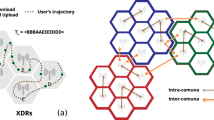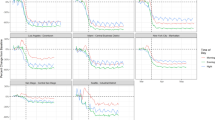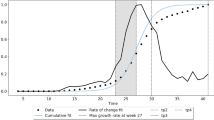Abstract
After more than a year of non-pharmaceutical interventions, such as, lock-downs and masks, questions remain on how effective these interventions were and could have been. The vast differences in the enforcement of and adherence to policies adds complexity to a problem already surrounded with significant uncertainty. This necessitates a model of disease transmission that can account for these spatial differences in interventions and compliance. In order to measure and predict the spread of disease under various intervention scenarios, we propose a Microscopic Markov Chain Approach (MMCA) in which spatial units each follow their own Markov process for the state of disease but are also connected through an underlying mobility matrix. Cuebiq, an offline intelligence and measurement company, provides aggregated, anonymized cell-phone mobility data which reveal how population behaviors have evolved over the course of the pandemic. These data are leveraged to infer mobility patterns across regions and contact patterns within those regions. The data enables the estimation of a baseline for how the pandemic spread under the true ground conditions, so that we can analyze how different shifts in mobility affect the spread of the disease. We demonstrate the efficacy of the model through a case study of spring break and it’s impact on how the infection spread in Florida during the spring of 2020, at the onset of the pandemic.
Access this chapter
Tax calculation will be finalised at checkout
Purchases are for personal use only
Similar content being viewed by others
References
Cuebiq. https://help.cuebiq.com/hc/en-us
Arenas, A., et al.: Modeling the spatiotemporal epidemic spreading of COVID-19 and the impact of mobility and social distancing interventions. Phys. Rev. X 10(4), 041055 (2020)
Bajardi, P., Poletto, C., Ramasco, J.J., Tizzoni, M., Colizza, V., Vespignani, A.: Human mobility networks, travel restrictions, and the global spread of 2009 H1N1 pandemic. PloS one 6(1), e16591 (2011)
Beaumont, P.: Eyam recalls lessons from 1665 battlewith plague. The Observer (2020)
Chang, S., et al.: Mobility network models of COVID-19 explain inequities and inform reopening. Nature 589(7840), 82–87 (2021)
Colizza, V., Barrat, A., Barthélemy, M., Vespignani, A.: The role of the airline transportation network in the prediction and predictability of global epidemics. Proc. Natl. Acad. Sci. 103(7), 2015–2020 (2006)
COVID-19 State and County Policy Orders. [Dataset]. U.S. Department of Health and Human Services (2021). https://catalog.data.gov/sr_Latn/dataset/covid-19-state-and-county-policy-orders-9408a
Del Moral, P., Doucet, A., Jasra, A.: An adaptive sequential Monte Carlo method for approximate Bayesian computation. Stat. Comput. 22(5), 1009–1020 (2012)
Dutta, R., Schoengens, M., Onnela, J.-P., Mira, A.: ABCpy: a user-friendly, extensible, and parallel library for approximate Bayesian computation. In Proceedings of the Platform for Advanced Scientific Computing Conference, pp. 1–9 (2017)
Editors, H.: First confirmed case of COVID-19 found in U.S. (2020). https://www.history.com/this-day-in-history/first-confirmed-case-of-coronavirus-found-in-us-washington-state
Engle, S., Stromme, J., Zhou, A.: Staying at home: The mobility effects of COVID-19. VOX, CEPR Policy Portal (2020). https://voxeu.org/article/staying-home-mobility-effects-covid-19
Cdc, P., et al.: Experiences with influenza-like illness and attitudes regarding influenza prevention-united states for disease control, 2003–04 influenza season. MMWR. Morbidity Mortality Weekly Rep. 53(49), 1156–1158 (2004). https://www.cdc.gov/mmwr/preview/mmwrhtml/mm5349a3.htm
Granell, C., Gómez, S., Arenas, A.: Competing spreading processes on multiplex networks: awareness and epidemics. Phys. Rev. E 90(1), 012808 (2014)
Green, J.: Plague. [podcast] The Anthropocene Reviewed (2020). https://www.wnycstudios.org/podcasts/anthropocene-reviewed/episodes/anthropocene-reviewed-john-green-plague, Accessed 5 Oct 2021
Gu, Y.: COVID-19 Projections for Miami-Dade, Fl, USA (2020). https://covid19-projections.com/us-fl-miami-dade
He, X., et al.: Temporal dynamics in viral shedding and transmissibility of COVID-19. Nat. Med. 26(5), 672–675 (2020)
Lauer, S.A., et al.: The incubation period of coronavirus disease 2019 (COVID-19) from publicly reported confirmed cases: estimation and application. Ann. Internal Med. 172(9), 577–582 (2020)
Laumann, E.O., Marsden, P.V., Prensky, D.: The boundary specification problem in network analysis. Res. Methods Soc. Netw. Anal. 61, 87 (1989)
Lavezzo, E., et al.: Suppression of a SARS-CoV-2 outbreak in the Italian municipality of Vo’. Nature 584(7821), 425–429 (2020)
Masters, N.B., Eisenberg, M.C., Delamater, P.L., Kay, M., Boulton, M.L., Zelner, J.: Fine-scale spatial clustering of measles non vaccination that increases outbreak potential is obscured by aggregated reporting data. Proc. Natl. Acad. Sci. 117(45), 28506–28514 (2020)
Li, Q., et al.: Early transmission dynamics in Wuhan, China, of novel coronavirus-infected pneumonia. New Engl. J. Med. 382, 1199–1207 (2020)
McCulloh, I., Kiernan, K., Kent, T.: Inferring true COVID19 infection rates from deaths. Front. Big Data 3, 37 (2020)
Pappalardo, L., Simini, F., Barlacchi, G., Pellungrini, R.: scikit-mobility: a Python library for the analysis, generation and risk assessment of mobility data (2019)
Roser, M.: Tourism. Our World in Data (2017). https://ourworldindata.org/tourism
Silverman, J.D., Hupert, N., Washburne, A.D.: Using influenza surveillance networks to estimate state-specific prevalence of SARS-CoV-2 in the United States. Sci. Transl. Med. 12(554), 1–9 (2020)
Verity, R., et al.: Estimates of the severity of coronavirus disease 2019: a model-based analysis. Lancet Infect. Dis. 20(6), 669–677 (2020)
Whittles, L.K., Didelot, X.: Epidemiological analysis of the Eyam plague outbreak of 1665–1666. Proc. Royal Soc. B Biol. Sci. 283(1830), 20160618 (2016)
Wang, Q., Phillips, N.E., Small, M.L., Sampson, R.J.: Urban mobility and neighborhood isolation in America’s 50 largest cities. Proc. Natl. Acad. Sci. 115(30), 7735–40 (2018)
Zhang, L., et al.: An interactive COVID-19 mobility impact and social distancing analysis platform. medRxiv (2020)
Zhao, S., et al.: Preliminary estimation of the basic reproduction number of novel coronavirus (2019-nCoV) in China, from 2019 to 2020: A data-driven analysis in the early phase of the outbreak. Int. J. Infect. Dis. 92, 214–217 (2020 ). PMID: 32007643; PMCID: PMC7110798. https://doi.org/10.1016/j.ijid.2020.01.050
Acknowledgements
This model was built in collaboration with Applied Intelligence Accenture Federal Services. The past year we served as members of their COVID-19 response team where we built and deployed models for decision support of various federal clients. We also appreciate Cuebiq’s Data for Good program for providing the mobility data needed for this analysis.
Author information
Authors and Affiliations
Corresponding author
Editor information
Editors and Affiliations
Rights and permissions
Copyright information
© 2022 The Author(s), under exclusive license to Springer Nature Switzerland AG
About this paper
Cite this paper
Kent, T.G., Phillips, N.E., McCulloh, I., Pavon-Harr, V., Patsolic, H.G. (2022). Microscopic Markov Chain Approach for Measuring Mobility Driven SARS-CoV-2 Transmission. In: Benito, R.M., Cherifi, C., Cherifi, H., Moro, E., Rocha, L.M., Sales-Pardo, M. (eds) Complex Networks & Their Applications X. COMPLEX NETWORKS 2021. Studies in Computational Intelligence, vol 1073. Springer, Cham. https://doi.org/10.1007/978-3-030-93413-2_26
Download citation
DOI: https://doi.org/10.1007/978-3-030-93413-2_26
Published:
Publisher Name: Springer, Cham
Print ISBN: 978-3-030-93412-5
Online ISBN: 978-3-030-93413-2
eBook Packages: EngineeringEngineering (R0)




